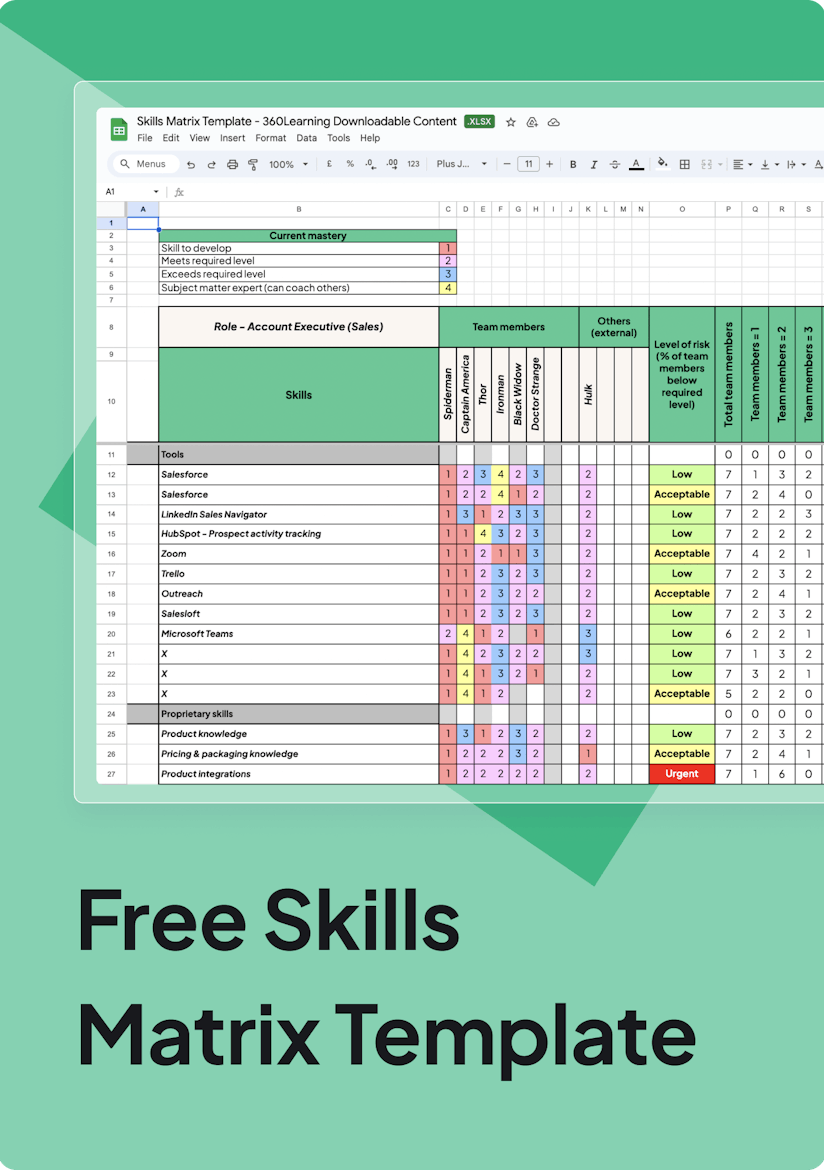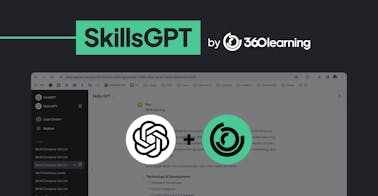
Many organizations struggle to deliver learning experiences that align with employee aspirations and lead to meaningful career outcomes—let alone significantly impact business results.
A talent-fueled enterprise transforms this dynamic by balancing personal and business outcomes. These organizations can foster loyalty, agility, and innovation to create a workforce empowered to thrive.
In this article, we explore The Talent-Fueled Enterprise, the latest book by Mike Ohata, featuring exclusive insights from the author. We’ll unpack the four core themes of a talent-fueled enterprise and share actionable strategies to shape the workforce of tomorrow.

A skills matrix template to save you hours.
By providing your contact info, you agree to receive communications from 360Learning. You can opt-out at any time. For details, refer to our Privacy Policy.
The talent-fueled enterprise
A talent-fueled enterprise recognizes, cultivates, and celebrates the wealth of talent within its organization.
The talent-fueled model transforms both the workforce and the workplace by embracing continuous learning. It focuses on future skills and the organization's heart—its people and the outcomes they deliver.
“Many talent models of the past have looked at employees as resources, but the talent-fueled enterprise is a workplace that values and cultivates employee potential and all of the potential of the organization,” says Mike Ohata, author of The Talent-Fueled Enterprise.
The talent-fueled enterprise is a workplace that values and cultivates employee potential and all of the potential of the organization," - Mike Ohata, author of The Talent-Fueled Enterprise.
From the employee’s perspective, it’s about feeling valued and supported in their growth, aligning personal development goals with meaningful outcomes. For the business, it’s about fostering a culture rooted in shared values, delivering a rich employee experience, and making workforce education a core element.
1. Balancing professional development and personal growth
Organizations have long optimized learning around professional development.
However, the talent-fueled enterprise includes personal growth as a key learning strategy. For example, a factory might focus on upskilling workers in automation or continuous improvement techniques, aligning with professional development goals.
“If we want an organization that has agility, we have to create or redesign the system of work to allow for agility,” says Mike.
“If we want an organization that has agility, we have to create or redesign the system of work to allow for agility,” - Mike.
The challenge is to escape a cycle in which internal mobility is hindered by skills ossified around specific roles. To break this loop, L&D teams should balance professional development with personal growth, offering employees chances to explore upskilling or reskilling opportunities.
2. Potential: even broken crayons can color
L&D should challenge systems that solely focus on high performance and high potential—systems that can often leave many employees behind.
“Even broken crayons can color. The idea is that everybody has potential,” says Mike.
“Even broken crayons can color. The idea is that everybody has potential,” - Mike.
Hiring practices often narrowly focus on specific tasks, overlooking attributes that indicate adaptability and a capacity to learn. Organizations should look to empower employees by recognizing their potential and investing in upskilling. Failure to do so often leads to high attrition and widening skills gaps as employees seek opportunities elsewhere.
3. Skills: the currency that matters
Many L&D and business leaders understand that skills are the power driving the organizations of tomorrow.
“Skills are the currency of the organization and the currency of the people themselves,” says Mike.
The L&D teams working to stay ahead of the curve and close the skills gaps in thier organizations are leveraging skills ontologies (with tools like SkillsGPT), a skills strategy, and optimizing and defining how the organization values those skills and mastery levels
“Skills are the currency of the organization and the currency of the people themselves,” - Mike.
A skills strategy should be the priority. It empowers employees to understand where they are in their journey and their professional growth. When developing your strategy, monitor the marketplace to understand the skills your organization needs and the skills your employees need to be successful professionals.
4. Ongoing transformation
A talent-fueled enterprise is an organization that balances the people part of development with professional development.
“One thing we say in transformation is to stop talking about workforce shaping. Transformation is something we do in partnership with our employees, not something we do to them,” says Mike.
“Transformation is something we do in partnership with our employees, not something we do to them,” - Mike.
In his book, Mike outlines the guidance and practices L&D professionals can implement to rebuild your organization’s systems. To get started, the first recommendation is to take on the skills piece because that will benefit everyone and the organization.
Tips for developing the workforce of tomorrow
There are many actionable steps you can take today to develop the workforce of tomorrow and shift toward being a talent-fueled enterprise.
1. Start with a skills strategy: Prioritize the skills that will give your organization the agility to stay competitive and focus on technical and personal growth opportunities to empower employees.
2. Invest in workforce experience: Tie learning experiences together holistically, from recruitment to onboarding, team collaboration, and career progression. Ensure every touchpoint fosters engagement, skill development, and personal growth.
“I do think the imperative for all of us is that whatever we desire for our workforce to be and the learning experience of our employees, that's the investment we've got to make,” says Mike.
“Whatever we desire for our workforce to be and the learning experience of our employees, that's the investment we've got to make,” - Mike.
3. Expand your L&D skillset to meet tomorrow’s needs:
- Coaching: Every L&D professional should have foundational coaching knowledge to guide teams and individuals effectively.
- Talent management: Build expertise in talent management principles to support workforce growth strategically.
- Business partnering: Understand how to align L&D strategies with broader business goals for maximum impact.
- Organizational design: Learn how to design experiences that connect individual growth with organizational goals—from onboarding to team integration.
4. Define what good looks like: Identify and balance the skills and experiences that drive personal and organizational success. In the process, continuously refine your understanding of what excellence means for your workforce as the business evolves.
Explore further insights on developing the workforce of tomorrow on the latest episode on The L&D Podcast: The Talent-Fueled Enterprise With Mike Ohata
Want more peer insights on transforming workplace learning? Sign up to become a member of the L&D Collective. Or you can subscribe below to our weekly newsletter to receive our latest posts directly in your inbox.




